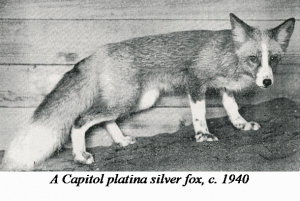
 Big Bear Valley, CA, November 8, 2014 – In the long history of the Big Bear Valley starting with the gold rush days of the 1860s, fox farming was certainly one of the more unique enterprises. Raising foxes for their beautiful furs dates from the 1890s when a consistent strain of valuable silver foxes was developed from the common red fox.
Big Bear Valley, CA, November 8, 2014 – In the long history of the Big Bear Valley starting with the gold rush days of the 1860s, fox farming was certainly one of the more unique enterprises. Raising foxes for their beautiful furs dates from the 1890s when a consistent strain of valuable silver foxes was developed from the common red fox.
Demand for fur was high at that time and profits were quite large, so many in the northern areas of the country became fox ranchers. This included the very successful R. T. Moore of Maine. He heard about the climate in Big Bear and realized it was ideal for raising foxes. Cool summer nights and cold winters are perfect conditions for the industry and the high altitude and dry air eliminated many internal and external pests.
In the 1920s, Moore purchased 84 acres east of Pine Knot, which he named the Borestone Ranch, and quickly built extensive pens and kennels. Today, the site of the original ranch is bordered by Fox Farm Rd., Teakwood Dr., Crater Lake Rd., and the rocky hills to the north.
The pen-raised silver foxes required diligent care and feeding. A fine pelt could command as much as $1,100 in those days, but it was the sale of breeding stock that was the primary objective of fox farming in the early years because it was much more profitable than selling pelts. Superior breeding pairs could bring as much as two to three thousand dollars.
Many people got into the fox farming business in Big Bear over the next decade or so. The Walter McAllister family arrived from Seattle in 1928 to take over management of the All Star Fox Farm Ranch. Even though these were the Depression years, the business prospered and even doubled in size during the 1930s. During its peak, the All Star was producing more than 1000 pelts per year and was the largest of 27 different fox farms operating between Sky Forest and Cactus Flats. Fox farming was the second most important industry in the valley after cattle ranching. It wasn’t long after that however, that the industry came to a close in Big Bear. This was due to the increased cost of food, a 20% luxury tax, and other countries such as Russia dumping shiploads of cheap fur on the world market.


